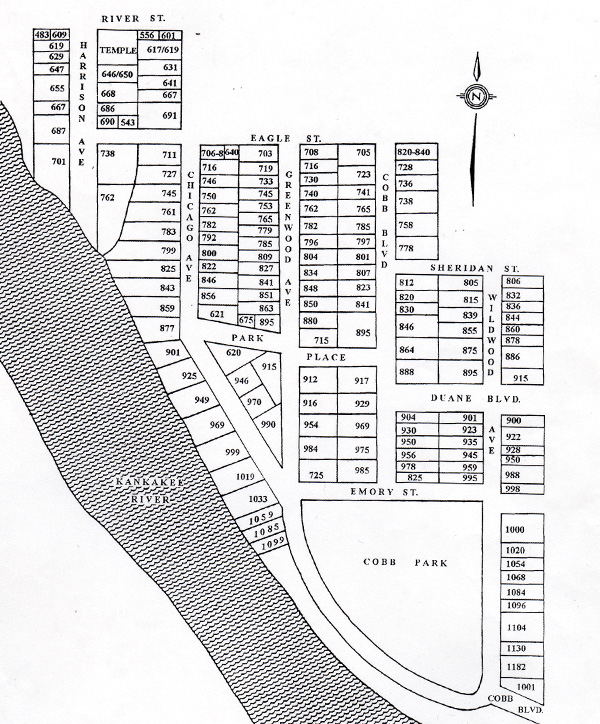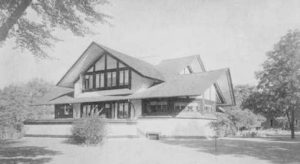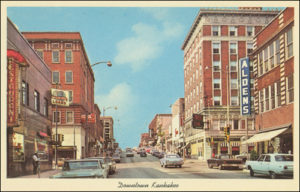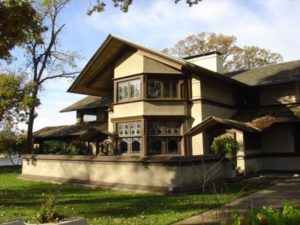
The Story of Our Neighborhood
The Riverview neighborhood sits on the banks of the Kankakee River. A portion of the Historic District was the grounds for the luxurious Hotel Riverview. The hotel was a favorite destination for local and Chicago society. It tragically burnt to the ground in 1897 making the land available for development into a neighborhood of finely crafted custom built homes for the movers and shakers of Kankakee. Riverview was born.
Beginning with the early 1860s Riverview has had an amazing time line of glory days, tragedy, and a renaissance. It is our hope that the Riverview Historic District can be a leading force for historic preservation, building community and infusing pride into the City of Kankakee.
1860 – 1900
A Famous Hotel
Mr. Cobb was instrumental in developing the Hotel Riverview which opened in 1887 at a cost of $80,000. The hotel consisted of 80 guest rooms, an immense covered veranda, tennis courts and croquet grounds, and beach access to the river complete with rowboats. The hotel flourished bringing Chicagos society folks by rail to enjoy relaxation on the river.
Over the next several years Kankakee experienced tremendous growth. The city became electrified, including the addition of electric trolley service. In 1891 the city’s population was over 7,000 residents. In 1893 the Hotel Riverview went into “year-round” operation with the addition of a furnace. Development along the Kankakee River continued with several projects culminating into the Electric Park – an amusement park that featured a roller coaster and dance hall.
Tragically, on November 12, 1897, the Hotel Riverview burned to the ground. A total loss, it would not be rebuilt. The land would be sold and subdivided for residential housing. The City of Kankakee bought land formerly occupied by Hotel Riverview and established what eventually became known as Cobb Park. The 1890s closed out with electric trolley service being extended to Electric Park on the east end of the neighborhood.
1901 – 1950
Decades of Change
 The first 50 years of the twentieth century began with the death of Queen Victoria. This period saw much change: electric trolleys succumb to the automobile; women became able to vote; prohibition came and went; we lived through two world wars and the dawning of the atomic age; we became entertained by radio and television.
The first 50 years of the twentieth century began with the death of Queen Victoria. This period saw much change: electric trolleys succumb to the automobile; women became able to vote; prohibition came and went; we lived through two world wars and the dawning of the atomic age; we became entertained by radio and television.
The City and County of Kankakee saw tremendous growth in business and residential populations. Even in this early period some of the old graceful houses were leveled for modern structures and the building of infrastructure. Many factories were built to produce product for the Sears, Roebuck and Company.
Many of the homes in what later became the Historic District area had already been built by 1910. Riverview became well known for the fine houses and were mostly safe from demolition. The addition of two Frank Lloyd Wright designed homes helped to cement Kankakee’s reputation for fine architecture and craftsmanship. In 1916 the Kankakee Country Club was established along the river at the east end of the Riverview neighborhood and was a major development in the District.
1951 – 2000
Modernization
 During the late 1950s and most of the 1960s many downtowns and older sections of neighborhoods under went “modernization”. The destruction of older buildings and residential structure was generally meant to make space available for new construction in the architectural style of the time – modernism – a style with simplistic lines and minimal decorations. Riverview was not exempt from these changes in taste.
During the late 1950s and most of the 1960s many downtowns and older sections of neighborhoods under went “modernization”. The destruction of older buildings and residential structure was generally meant to make space available for new construction in the architectural style of the time – modernism – a style with simplistic lines and minimal decorations. Riverview was not exempt from these changes in taste.
Several large homes of the 1860 – 1920 era were razed for building 1960s ranch-style homes, several multi-unit buildings were constructed. Many of Riverview’s larger homes were converted into multi-unit apartment buildings.
Throughout the 1970s and 1980s over ten thousand manufacturing jobs left Kankakee County. This resulted in a general decline of economic vitality in the county. More retail stores left downtown Kankakee for Meadowview Shopping Center, an outdoor retail concept built on the north side of Kankakee. In the 1980s a modern indoor mall was built in Bradley, a village north of Kankakee, further draining retail from downtown Kankakee. While popular residential trends moved to the northern portion of the area there was a group of residents who never stopped promoting the unique qualities of life in Riverview.
Today
Kankakee’s Comeback
 In the late 1980’s several prominent homes from 1880 – 1900 period were purchased, renovated, and returned to their former glory as single family homes. These resurrection projects became the catalyst for preserving the historical structures and for the growing pride of the Riverview neighborhood. In 1986 a group of Riverview residents took it upon themselves to lead an effort to establish the Riverview Historic District. On August 22, 1986 the Riverview Historic District was added to the National Register of Historic Places.
In the late 1980’s several prominent homes from 1880 – 1900 period were purchased, renovated, and returned to their former glory as single family homes. These resurrection projects became the catalyst for preserving the historical structures and for the growing pride of the Riverview neighborhood. In 1986 a group of Riverview residents took it upon themselves to lead an effort to establish the Riverview Historic District. On August 22, 1986 the Riverview Historic District was added to the National Register of Historic Places.
With the turn of the millennium the Riverview Historic District saw in influx of new residents. Many were returning from college elsewhere to start their families in the neighborhood of their childhood memories. Other new residents were discovering the amazing value of residential property in Riverview and moved from the Chicagoland area to Kankakee, which is only a short 60 minute drive from Chicago’s Loop.
In recent years the Riverview Historic District has become an exciting community of engaged residents sharing pride in their distinct homes and charm in an area that has become an anchor for the revitalization of the City of Kankakee.
